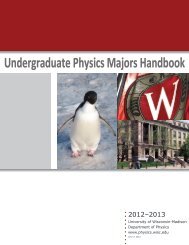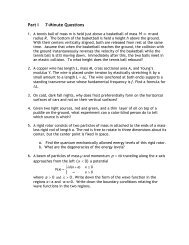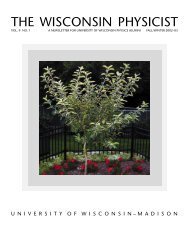neutrino
neutrino
neutrino
Create successful ePaper yourself
Turn your PDF publications into a flip-book with our unique Google optimized e-Paper software.
E I: Branching fractions for the two-body gravi<br />
into different R-parity violating channels for diffe<br />
s [15].<br />
Particle/mode mass B τ or<br />
ψ 3/2 → l + l − ν 400 GeV B τ =2<br />
ψ 3/2 → (Wl,Zν, γν) 400 GeV B τ =2<br />
χ → µ + µ − 2TeV B τ =2<br />
B (1) → (q¯q, l + l − ,W + W − ,ZZ,ν¯ν) 800GeVB =2<br />
χχ → µ + µ − 1TeV B =4<br />
E II: Model parameters characterizing fits to exp<br />
than the value required for a thermal relic abundance<br />
[34]: 〈σv〉 0 =3× 10 −26 cm 3 s −1 . Following the current<br />
convention, we write<br />
〈σv〉 = B 〈σv〉 0 , (1)<br />
with a boost factor B. There are theoretical evaluations<br />
of the boost factor [35], however, we treat the boost factor<br />
as a phenomenological parameter in this paper. To<br />
explain the lepton excesses, some models have constraints<br />
on the boost factor as a function of DM mass [16].<br />
In leptophilic DM<br />
models [7, 16] explaining the<br />
PAMELA positron excess, the DM annihilation or decay<br />
must proceed dominantly to leptons in order to avoid<br />
the overproduction of antiprotons. Moreover, according<br />
to the FERMI data, the direct production of electrons<br />
must be suppressed with respect to the production of<br />
electrons (and positrons) as secondaries. It was shown<br />
[16] that the leptophilic DM with mass (m χ ) in the range<br />
between 150 GeV and a few TeV, which annihilates or<br />
decays into τ’s or µ’s can fit the PAMELA [4] and Fermi<br />
[5] data as well as the HESS high energy photon data [6].<br />
The best fit parameters for the boost factor (B) andthe<br />
decay time (τ) which determine the overall normalizations,<br />
for the specific case involving muons from annihilation<br />
(χχ → µ + µ − )ordecay(χ → µ + µ − ), respectively,<br />
are given by [16]<br />
B = 431m χ − 38.9<br />
τ =<br />
(<br />
2.29 + 1.182<br />
m χ )<br />
× 10 26 sec<br />
= B τ × 10 26 sec (2)<br />
for m χ in TeV. The annihilation channel into tau pairs<br />
is less favored by the data [16].<br />
Some Kaluza-Klein models can provide a DM candidate<br />
which gives the correct relic density [30].<br />
To account<br />
for the HESS results [6], the lightest Kaluza-Klein<br />
particle (LKP) would have a mass of the order of a TeV<br />
[14]. The LKP is also assumed to be neutral and nonbaryonic.<br />
In this model, the particle couplings are fixed<br />
such that LKP pairs annihilate into quark pairs (35%),<br />
charged lepton pairs (59%), <strong>neutrino</strong>s (4%), gauge bosons<br />
(1.5%) and higgs bosons (0.5%) [14, 30].<br />
The first DM candidate proposed in the context of supersymmetry<br />
is the gravitino (ψ 3/2 ) which would be the<br />
lightest supersymmetric particle (LSP). The gravitino is<br />
the superpartner of the graviton. With the existence of<br />
small R-parity breaking to allow the LSP to decay, the<br />
gravitino decays into standard model particles. The decay<br />
rate of the gravitino in this scenario is so small that<br />
it can have a sufficiently long lifetime for the correct DM<br />
relic density today.<br />
GeV and few TeV [17]. To explain the data, the threebody<br />
gravitino decay mode (ψ 3/2 → l + l − ν) was considered<br />
[17]. We use the parameters of this model to explore<br />
<strong>neutrino</strong> signals from gravitino decay. For illustration, in<br />
addition to three-body decay, we also consider the twobody<br />
gravitino decay modes (ψ 3/2<br />
→ (W ∓ l ± ,Zν, γν))<br />
assuming the same lifetime and mass as for the threebody<br />
decay, and with the branching fractions given in<br />
Table I.<br />
m ψ3/2 (GeV) B F (ψ 3/2 → γν) B F (ψ 3/2 → Wl) B F (ψ 3/2 → Zν)<br />
10 1 0 0<br />
85 0.66 0.34 0<br />
100 0.16 0.76 0.08<br />
150 0.05 0.71 0.24<br />
200 0.03 0.69 0.28<br />
400 0.03 0.68 0.29<br />
TABLE I: Branching fractions for the two-body gravitino<br />
decay into different R-parity violating channels for different<br />
masses [15].<br />
Particle/mode mass B τ or B<br />
ψ 3/2 → l + l − ν 400 GeV B τ =2.3<br />
ψ 3/2 → (Wl,Zν, γν) 400 GeV B τ =2.3<br />
χ → µ + µ − 2TeV B τ =2.9<br />
B (1) B (1) → (q¯q, l + l − ,W + W − ,ZZ,ν¯ν) 800GeVB =200<br />
χχ → µ + µ − 1TeV B =400<br />
TABLE II: Model parameters characterizing fits to explain<br />
FERMI and PAMELA anomalies used as examples in this<br />
paper.<br />
Selected DM model parameters are shown in Table II.<br />
For each of the DM models considered, the decay distribution<br />
of the produced particles to <strong>neutrino</strong>s in case<br />
of DM annihilation, or the gravitino decay distribution<br />
to <strong>neutrino</strong>s, enters into the calculation of the <strong>neutrino</strong><br />
fluxes that arrive at Earth. For annihilation directly to<br />
<strong>neutrino</strong>s, the energy distribution of each <strong>neutrino</strong> is a<br />
delta function in energy, with the energy equal to the DM<br />
mass. This case has been well studied in the literature<br />
[21, 31, 32, 36]. Here, we look at the secondary <strong>neutrino</strong>s.<br />
Fig. 1 shows <strong>neutrino</strong> spectra, plotted in terms<br />
of x ≡ E ν /E ν,max where E ν,max = m χ for annihilating<br />
DM and E ν,max = m χ /2 for decaying DM models. The<br />
curves in the figure are normalized to count the number<br />
of <strong>neutrino</strong>s, and in the case of the Zν final state, the<br />
fraction of Z decays to <strong>neutrino</strong>s. The muon <strong>neutrino</strong><br />
spectra in the figure should be multiplied by the branching<br />
fraction for a specific decay channel in a given model.<br />
than the value required for a thermal relic abundance<br />
[34]: 〈σv〉 0 =3× 10 −26 cm 3 s −1 . Following the current<br />
convention, we write<br />
〈σv〉 = B 〈σv〉 0 , (1)<br />
with a boost factor B. There are theoretical evaluations<br />
of the boost factor [35], however, we treat the boost factor<br />
as a phenomenological parameter in this paper. To<br />
explain the lepton excesses, some models have constraints<br />
on the boost factor as a function of DM mass [16].<br />
In leptophilic DM<br />
models [7, 16] explaining the<br />
PAMELA positron excess, the DM annihilation or decay<br />
must proceed dominantly to leptons in order to avoid<br />
the overproduction of antiprotons. Moreover, according<br />
to the FERMI data, the direct production of electrons<br />
must be suppressed with respect to the production of<br />
electrons (and positrons) as secondaries. It was shown<br />
[16] that the leptophilic DM with mass (m χ ) in the range<br />
between 150 GeV and a few TeV, which annihilates or<br />
decays into τ’s or µ’s can fit the PAMELA [4] and Fermi<br />
[5] data as well as the HESS high energy photon data [6].<br />
The best fit parameters for the boost factor (B) andthe<br />
decay time (τ) which determine the overall normalizations,<br />
for the specific case involving muons from annihilation<br />
(χχ → µ + µ − )ordecay(χ → µ + µ − ), respectively,<br />
are given by [16]<br />
B = 431m χ − 38.9<br />
τ =<br />
(<br />
2.29 + 1.182<br />
m χ )<br />
× 10 26 sec<br />
= B τ × 10 26 sec (2)<br />
for m χ in TeV. The annihilation channel into tau pairs<br />
is less favored by the data [16].<br />
Some Kaluza-Klein models can provide a DM candidate<br />
which gives the correct relic density [30].<br />
To account<br />
for the HESS results [6], the lightest Kaluza-Klein<br />
particle (LKP) would have a mass of the order of a TeV<br />
[14]. The LKP is also assumed to be neutral and nonbaryonic.<br />
In this model, the particle couplings are fixed<br />
such that LKP pairs annihilate into quark pairs (35%),<br />
charged lepton pairs (59%), <strong>neutrino</strong>s (4%), gauge bosons<br />
(1.5%) and higgs bosons (0.5%) [14, 30].<br />
The first DM candidate proposed in the context of supersymmetry<br />
is the gravitino (ψ 3/2 ) which would be the<br />
lightest supersymmetric particle (LSP). The gravitino is<br />
the superpartner of the graviton. With the existence of<br />
small R-parity breaking to allow the LSP to decay, the<br />
gravitino decays into standard model particles. The decay<br />
rate of the gravitino in this scenario is so small that<br />
it can have a sufficiently long lifetime for the correct DM<br />
relic density today.<br />
GeV and few TeV [17]. To explain the data, the threebody<br />
gravitino decay mode (ψ 3/2 → l + l − ν) was considered<br />
[17]. We use the parameters of this model to explore<br />
<strong>neutrino</strong> signals from gravitino decay. For illustration, in<br />
addition to three-body decay, we also consider the twobody<br />
gravitino decay modes (ψ 3/2<br />
→ (W ∓ l ± ,Zν, γν))<br />
assuming the same lifetime and mass as for the threebody<br />
decay, and with the branching fractions given in<br />
Table I.<br />
m ψ3/2 (GeV) B F (ψ 3/2 → γν) B F (ψ 3/2 → Wl) B F (ψ 3/2 → Zν)<br />
10 1 0 0<br />
85 0.66 0.34 0<br />
100 0.16 0.76 0.08<br />
150 0.05 0.71 0.24<br />
200 0.03 0.69 0.28<br />
400 0.03 0.68 0.29<br />
TABLE I: Branching fractions for the two-body gravitino<br />
decay into different R-parity violating channels for different<br />
masses [15].<br />
Particle/mode mass B τ or B<br />
ψ 3/2 → l + l − ν 400 GeV B τ =2.3<br />
ψ 3/2 → (Wl,Zν, γν) 400 GeV B τ =2.3<br />
χ → µ + µ − 2TeV B τ =2.9<br />
B (1) B (1) → (q¯q, l + l − ,W + W − ,ZZ,ν¯ν) 800GeVB =200<br />
χχ → µ + µ − 1TeV B =400<br />
TABLE II: Model parameters characterizing fits to explain<br />
FERMI and PAMELA anomalies used as examples in this<br />
paper.<br />
Selected DM model parameters are shown in Table II.<br />
For each of the DM models considered, the decay distribution<br />
of the produced particles to <strong>neutrino</strong>s in case<br />
of DM annihilation, or the gravitino decay distribution<br />
to <strong>neutrino</strong>s, enters into the calculation of the <strong>neutrino</strong><br />
fluxes that arrive at Earth. For annihilation directly to<br />
<strong>neutrino</strong>s, the energy distribution of each <strong>neutrino</strong> is a<br />
delta function in energy, with the energy equal to the DM<br />
mass. This case has been well studied in the literature<br />
[21, 31, 32, 36]. Here, we look at the secondary <strong>neutrino</strong>s.<br />
Fig. 1 shows <strong>neutrino</strong> spectra, plotted in terms<br />
of x ≡ E ν /E ν,max where E ν,max = m χ for annihilating<br />
DM and E ν,max = m χ /2 for decaying DM models. The<br />
curves in the figure are normalized to count the number<br />
of <strong>neutrino</strong>s, and in the case of the Zν final state, the<br />
fraction of Z decays to <strong>neutrino</strong>s. The muon <strong>neutrino</strong><br />
spectra in the figure should be multiplied by the branching<br />
fraction for a specific decay channel in a given model.<br />
than the value required for a thermal relic abundance<br />
[34]: 〈σv〉 0 =3× 10 −26 cm 3 s −1 . Following the current<br />
convention, we write<br />
〈σv〉 = B 〈σv〉 0 , (1)<br />
with a boost factor B. There are theoretical evaluations<br />
of the boost factor [35], however, we treat the boost factor<br />
as a phenomenological parameter in this paper. To<br />
explain the lepton excesses, some models have constraints<br />
on the boost factor as a function of DM mass [16].<br />
In leptophilic DM<br />
models [7, 16] explaining the<br />
PAMELA positron excess, the DM annihilation or decay<br />
must proceed dominantly to leptons in order to avoid<br />
the overproduction of antiprotons. Moreover, according<br />
to the FERMI data, the direct production of electrons<br />
must be suppressed with respect to the production of<br />
electrons (and positrons) as secondaries. It was shown<br />
[16] that the leptophilic DM with mass (m χ ) in the range<br />
between 150 GeV and a few TeV, which annihilates or<br />
decays into τ’s or µ’s can fit the PAMELA [4] and Fermi<br />
[5] data as well as the HESS high energy photon data [6].<br />
The best fit parameters for the boost factor (B) andthe<br />
decay time (τ) which determine the overall normalizations,<br />
for the specific case involving muons from annihilation<br />
(χχ → µ + µ − )ordecay(χ → µ + µ − ), respectively,<br />
are given by [16]<br />
B = 431m χ − 38.9<br />
τ =<br />
(<br />
2.29 + 1.182<br />
m χ )<br />
× 10 26 sec<br />
= B τ × 10 26 sec (2)<br />
for m χ in TeV. The annihilation channel into tau pairs<br />
is less favored by the data [16].<br />
Some Kaluza-Klein models can provide a DM candidate<br />
which gives the correct relic density [30].<br />
To account<br />
for the HESS results [6], the lightest Kaluza-Klein<br />
particle (LKP) would have a mass of the order of a TeV<br />
[14]. The LKP is also assumed to be neutral and nonbaryonic.<br />
In this model, the particle couplings are fixed<br />
such that LKP pairs annihilate into quark pairs (35%),<br />
charged lepton pairs (59%), <strong>neutrino</strong>s (4%), gauge bosons<br />
(1.5%) and higgs bosons (0.5%) [14, 30].<br />
The first DM candidate proposed in the context of supersymmetry<br />
is the gravitino (ψ 3/2 ) which would be the<br />
lightest supersymmetric particle (LSP). The gravitino is<br />
the superpartner of the graviton. With the existence of<br />
small R-parity breaking to allow the LSP to decay, the<br />
gravitino decays into standard model particles. The decay<br />
rate of the gravitino in this scenario is so small that<br />
it can have a sufficiently long lifetime for the correct DM<br />
relic density today.<br />
GeV and few TeV [17]. To explain the data, the threebody<br />
gravitino decay mode (ψ 3/2 → l + l − ν) was considered<br />
[17]. We use the parameters of this model to explore<br />
<strong>neutrino</strong> signals from gravitino decay. For illustration, in<br />
addition to three-body decay, we also consider the twobody<br />
gravitino decay modes (ψ 3/2<br />
→ (W ∓ l ± ,Zν, γν))<br />
assuming the same lifetime and mass as for the threebody<br />
decay, and with the branching fractions given in<br />
Table I.<br />
m ψ3/2 (GeV) B F (ψ 3/2 → γν) B F (ψ 3/2 → Wl) B F (ψ 3/2 → Zν)<br />
10 1 0 0<br />
85 0.66 0.34 0<br />
100 0.16 0.76 0.08<br />
150 0.05 0.71 0.24<br />
200 0.03 0.69 0.28<br />
400 0.03 0.68 0.29<br />
TABLE I: Branching fractions for the two-body gravitino<br />
decay into different R-parity violating channels for different<br />
masses [15].<br />
Particle/mode mass B τ or B<br />
ψ 3/2 → l + l − ν 400 GeV B τ =2.3<br />
ψ 3/2 → (Wl,Zν, γν) 400 GeV B τ =2.3<br />
χ → µ + µ − 2TeV B τ =2.9<br />
B (1) B (1) → (q¯q, l + l − ,W + W − ,ZZ,ν¯ν) 800GeVB =200<br />
χχ → µ + µ − 1TeV B =400<br />
TABLE II: Model parameters characterizing fits to explain<br />
FERMI and PAMELA anomalies used as examples in this<br />
paper.<br />
Selected DM model parameters are shown in Table II.<br />
For each of the DM models considered, the decay distribution<br />
of the produced particles to <strong>neutrino</strong>s in case<br />
of DM annihilation, or the gravitino decay distribution<br />
to <strong>neutrino</strong>s, enters into the calculation of the <strong>neutrino</strong><br />
fluxes that arrive at Earth. For annihilation directly to<br />
<strong>neutrino</strong>s, the energy distribution of each <strong>neutrino</strong> is a<br />
delta function in energy, with the energy equal to the DM<br />
mass. This case has been well studied in the literature<br />
[21, 31, 32, 36]. Here, we look at the secondary <strong>neutrino</strong>s.<br />
Fig. 1 shows <strong>neutrino</strong> spectra, plotted in terms<br />
of x ≡ E ν /E ν,max where E ν,max = m χ for annihilating<br />
DM and E ν,max = m χ /2 for decaying DM models. The<br />
curves in the figure are normalized to count the number<br />
of <strong>neutrino</strong>s, and in the case of the Zν final state, the<br />
fraction of Z decays to <strong>neutrino</strong>s. The muon <strong>neutrino</strong><br />
spectra in the figure should be multiplied by the branching<br />
fraction for a specific decay channel in a given model.<br />
than the value required for a thermal relic abundance<br />
[34]: 〈σv〉 0 =3× 10 −26 cm 3 s −1 . Following the current<br />
convention, we write<br />
〈σv〉 = B 〈σv〉 0 , (1)<br />
with a boost factor B. There are theoretical evaluations<br />
of the boost factor [35], however, we treat the boost factor<br />
as a phenomenological parameter in this paper. To<br />
explain the lepton excesses, some models have constraints<br />
on the boost factor as a function of DM mass [16].<br />
In leptophilic DM<br />
models [7, 16] explaining the<br />
PAMELA positron excess, the DM annihilation or decay<br />
must proceed dominantly to leptons in order to avoid<br />
the overproduction of antiprotons. Moreover, according<br />
to the FERMI data, the direct production of electrons<br />
must be suppressed with respect to the production of<br />
electrons (and positrons) as secondaries. It was shown<br />
[16] that the leptophilic DM with mass (m χ ) in the range<br />
between 150 GeV and a few TeV, which annihilates or<br />
decays into τ’s or µ’s can fit the PAMELA [4] and Fermi<br />
[5] data as well as the HESS high energy photon data [6].<br />
The best fit parameters for the boost factor (B) andthe<br />
decay time (τ) which determine the overall normalizations,<br />
for the specific case involving muons from annihilation<br />
(χχ → µ + µ − )ordecay(χ → µ + µ − ), respectively,<br />
are given by [16]<br />
B = 431m χ − 38.9<br />
τ =<br />
(<br />
2.29 + 1.182<br />
m χ )<br />
× 10 26 sec<br />
= B τ × 10 26 sec (2)<br />
for m χ in TeV. The annihilation channel into tau pairs<br />
is less favored by the data [16].<br />
Some Kaluza-Klein models can provide a DM candidate<br />
which gives the correct relic density [30].<br />
To account<br />
for the HESS results [6], the lightest Kaluza-Klein<br />
particle (LKP) would have a mass of the order of a TeV<br />
[14]. The LKP is also assumed to be neutral and nonbaryonic.<br />
In this model, the particle couplings are fixed<br />
such that LKP pairs annihilate into quark pairs (35%),<br />
charged lepton pairs (59%), <strong>neutrino</strong>s (4%), gauge bosons<br />
(1.5%) and higgs bosons (0.5%) [14, 30].<br />
The first DM candidate proposed in the context of supersymmetry<br />
is the gravitino (ψ 3/2 ) which would be the<br />
lightest supersymmetric particle (LSP). The gravitino is<br />
the superpartner of the graviton. With the existence of<br />
small R-parity breaking to allow the LSP to decay, the<br />
gravitino decays into standard model particles. The decay<br />
rate of the gravitino in this scenario is so small that<br />
it can have a sufficiently long lifetime for the correct DM<br />
relic density today.<br />
GeV and few TeV [17]. To explain the data, the threebody<br />
gravitino decay mode (ψ 3/2 → l + l − ν) was considered<br />
[17]. We use the parameters of this model to explore<br />
<strong>neutrino</strong> signals from gravitino decay. For illustration, in<br />
addition to three-body decay, we also consider the twobody<br />
gravitino decay modes (ψ 3/2<br />
→ (W ∓ l ± ,Zν, γν))<br />
assuming the same lifetime and mass as for the threebody<br />
decay, and with the branching fractions given in<br />
Table I.<br />
m ψ3/2 (GeV) B F (ψ 3/2 → γν) B F (ψ 3/2 → Wl) B F (ψ 3/2 → Zν)<br />
10 1 0 0<br />
85 0.66 0.34 0<br />
100 0.16 0.76 0.08<br />
150 0.05 0.71 0.24<br />
200 0.03 0.69 0.28<br />
400 0.03 0.68 0.29<br />
TABLE I: Branching fractions for the two-body gravitino<br />
decay into different R-parity violating channels for different<br />
masses [15].<br />
Particle/mode mass B τ or B<br />
ψ 3/2 → l + l − ν 400 GeV B τ =2.3<br />
ψ 3/2 → (Wl,Zν, γν) 400 GeV B τ =2.3<br />
χ → µ + µ − 2TeV B τ =2.9<br />
B (1) B (1) → (q¯q, l + l − ,W + W − ,ZZ,ν¯ν) 800GeVB =200<br />
χχ → µ + µ − 1TeV B =400<br />
TABLE II: Model parameters characterizing fits to explain<br />
FERMI and PAMELA anomalies used as examples in this<br />
paper.<br />
Selected DM model parameters are shown in Table II.<br />
For each of the DM models considered, the decay distribution<br />
of the produced particles to <strong>neutrino</strong>s in case<br />
of DM annihilation, or the gravitino decay distribution<br />
to <strong>neutrino</strong>s, enters into the calculation of the <strong>neutrino</strong><br />
fluxes that arrive at Earth. For annihilation directly to<br />
<strong>neutrino</strong>s, the energy distribution of each <strong>neutrino</strong> is a<br />
delta function in energy, with the energy equal to the DM<br />
mass. This case has been well studied in the literature<br />
[21, 31, 32, 36]. Here, we look at the secondary <strong>neutrino</strong>s.<br />
Fig. 1 shows <strong>neutrino</strong> spectra, plotted in terms<br />
of x ≡ E ν /E ν,max where E ν,max = m χ for annihilating<br />
DM and E ν,max = m χ /2 for decaying DM models. The<br />
curves in the figure are normalized to count the number<br />
of <strong>neutrino</strong>s, and in the case of the Zν final state, the<br />
fraction of Z decays to <strong>neutrino</strong>s. The muon <strong>neutrino</strong><br />
spectra in the figure should be multiplied by the branching<br />
fraction for a specific decay channel in a given model.<br />
than the value required for a thermal relic abundance<br />
[34]: 〈σv〉 0 =3× 10 −26 cm 3 s −1 . Following the current<br />
convention, we write<br />
〈σv〉 = B 〈σv〉 0 , (1)<br />
with a boost factor B. There are theoretical evaluations<br />
of the boost factor [35], however, we treat the boost factor<br />
as a phenomenological parameter in this paper. To<br />
explain the lepton excesses, some models have constraints<br />
on the boost factor as a function of DM mass [16].<br />
In leptophilic DM<br />
models [7, 16] explaining the<br />
PAMELA positron excess, the DM annihilation or decay<br />
must proceed dominantly to leptons in order to avoid<br />
the overproduction of antiprotons. Moreover, according<br />
to the FERMI data, the direct production of electrons<br />
must be suppressed with respect to the production of<br />
electrons (and positrons) as secondaries. It was shown<br />
[16] that the leptophilic DM with mass (m χ ) in the range<br />
between 150 GeV and a few TeV, which annihilates or<br />
decays into τ’s or µ’s can fit the PAMELA [4] and Fermi<br />
[5] data as well as the HESS high energy photon data [6].<br />
The best fit parameters for the boost factor (B) andthe<br />
decay time (τ) which determine the overall normalizations,<br />
for the specific case involving muons from annihilation<br />
(χχ → µ + µ − )ordecay(χ → µ + µ − ), respectively,<br />
are given by [16]<br />
B = 431m χ − 38.9<br />
τ =<br />
(<br />
2.29 + 1.182<br />
m χ )<br />
× 10 26 sec<br />
= B τ × 10 26 sec (2)<br />
for m χ in TeV. The annihilation channel into tau pairs<br />
is less favored by the data [16].<br />
Some Kaluza-Klein models can provide a DM candidate<br />
which gives the correct relic density [30].<br />
To account<br />
for the HESS results [6], the lightest Kaluza-Klein<br />
particle (LKP) would have a mass of the order of a TeV<br />
[14]. The LKP is also assumed to be neutral and nonbaryonic.<br />
In this model, the particle couplings are fixed<br />
such that LKP pairs annihilate into quark pairs (35%),<br />
charged lepton pairs (59%), <strong>neutrino</strong>s (4%), gauge bosons<br />
(1.5%) and higgs bosons (0.5%) [14, 30].<br />
The first DM candidate proposed in the context of supersymmetry<br />
is the gravitino (ψ 3/2 ) which would be the<br />
lightest supersymmetric particle (LSP). The gravitino is<br />
the superpartner of the graviton. With the existence of<br />
small R-parity breaking to allow the LSP to decay, the<br />
gravitino decays into standard model particles. The decay<br />
rate of the gravitino in this scenario is so small that<br />
it can have a sufficiently long lifetime for the correct DM<br />
relic density today.<br />
GeV and few TeV [17]. To explain the data, the threebody<br />
gravitino decay mode (ψ 3/2 → l + l − ν) was considered<br />
[17]. We use the parameters of this model to explore<br />
<strong>neutrino</strong> signals from gravitino decay. For illustration, in<br />
addition to three-body decay, we also consider the twobody<br />
gravitino decay modes (ψ 3/2<br />
→ (W ∓ l ± ,Zν, γν))<br />
assuming the same lifetime and mass as for the threebody<br />
decay, and with the branching fractions given in<br />
Table I.<br />
m ψ3/2 (GeV) B F (ψ 3/2 → γν) B F (ψ 3/2 → Wl) B F (ψ 3/2 → Zν)<br />
10 1 0 0<br />
85 0.66 0.34 0<br />
100 0.16 0.76 0.08<br />
150 0.05 0.71 0.24<br />
200 0.03 0.69 0.28<br />
400 0.03 0.68 0.29<br />
TABLE I: Branching fractions for the two-body gravitino<br />
decay into different R-parity violating channels for different<br />
masses [15].<br />
Particle/mode mass B τ or B<br />
ψ 3/2 → l + l − ν 400 GeV B τ =2.3<br />
ψ 3/2 → (Wl,Zν, γν) 400 GeV B τ =2.3<br />
χ → µ + µ − 2TeV B τ =2.9<br />
B (1) B (1) → (q¯q, l + l − ,W + W − ,ZZ,ν¯ν) 800GeVB =200<br />
χχ → µ + µ − 1TeV B =400<br />
TABLE II: Model parameters characterizing fits to explain<br />
FERMI and PAMELA anomalies used as examples in this<br />
paper.<br />
Selected DM model parameters are shown in Table II.<br />
For each of the DM models considered, the decay distribution<br />
of the produced particles to <strong>neutrino</strong>s in case<br />
of DM annihilation, or the gravitino decay distribution<br />
to <strong>neutrino</strong>s, enters into the calculation of the <strong>neutrino</strong><br />
fluxes that arrive at Earth. For annihilation directly to<br />
<strong>neutrino</strong>s, the energy distribution of each <strong>neutrino</strong> is a<br />
delta function in energy, with the energy equal to the DM<br />
mass. This case has been well studied in the literature<br />
[21, 31, 32, 36]. Here, we look at the secondary <strong>neutrino</strong>s.<br />
Fig. 1 shows <strong>neutrino</strong> spectra, plotted in terms<br />
of x ≡ E ν /E ν,max where E ν,max = m χ for annihilating<br />
DM and E ν,max = m χ /2 for decaying DM models. The<br />
curves in the figure are normalized to count the number<br />
of <strong>neutrino</strong>s, and in the case of the Zν final state, the<br />
fraction of Z decays to <strong>neutrino</strong>s. The muon <strong>neutrino</strong><br />
spectra in the figure should be multiplied by the branching<br />
fraction for a specific decay channel in a given model.<br />
than the value required for a thermal relic abundance<br />
[34]: 〈σv〉 0 =3× 10 −26 cm 3 s −1 . Following the current<br />
convention, we write<br />
〈σv〉 = B 〈σv〉 0 , (1)<br />
with a boost factor B. There are theoretical evaluations<br />
of the boost factor [35], however, we treat the boost factor<br />
as a phenomenological parameter in this paper. To<br />
explain the lepton excesses, some models have constraints<br />
on the boost factor as a function of DM mass [16].<br />
In leptophilic DM<br />
models [7, 16] explaining the<br />
PAMELA positron excess, the DM annihilation or decay<br />
must proceed dominantly to leptons in order to avoid<br />
the overproduction of antiprotons. Moreover, according<br />
to the FERMI data, the direct production of electrons<br />
must be suppressed with respect to the production of<br />
electrons (and positrons) as secondaries. It was shown<br />
[16] that the leptophilic DM with mass (m χ ) in the range<br />
between 150 GeV and a few TeV, which annihilates or<br />
decays into τ’s or µ’s can fit the PAMELA [4] and Fermi<br />
[5] data as well as the HESS high energy photon data [6].<br />
The best fit parameters for the boost factor (B) andthe<br />
decay time (τ) which determine the overall normalizations,<br />
for the specific case involving muons from annihilation<br />
(χχ → µ + µ − )ordecay(χ → µ + µ − ), respectively,<br />
are given by [16]<br />
B = 431m χ − 38.9<br />
τ =<br />
(<br />
2.29 + 1.182<br />
m χ )<br />
× 10 26 sec<br />
= B τ × 10 26 sec (2)<br />
for m χ in TeV. The annihilation channel into tau pairs<br />
is less favored by the data [16].<br />
Some Kaluza-Klein models can provide a DM candidate<br />
which gives the correct relic density [30].<br />
To account<br />
for the HESS results [6], the lightest Kaluza-Klein<br />
particle (LKP) would have a mass of the order of a TeV<br />
[14]. The LKP is also assumed to be neutral and nonbaryonic.<br />
In this model, the particle couplings are fixed<br />
such that LKP pairs annihilate into quark pairs (35%),<br />
charged lepton pairs (59%), <strong>neutrino</strong>s (4%), gauge bosons<br />
(1.5%) and higgs bosons (0.5%) [14, 30].<br />
The first DM candidate proposed in the context of supersymmetry<br />
is the gravitino (ψ 3/2 ) which would be the<br />
lightest supersymmetric particle (LSP). The gravitino is<br />
the superpartner of the graviton. With the existence of<br />
small R-parity breaking to allow the LSP to decay, the<br />
gravitino decays into standard model particles. The decay<br />
rate of the gravitino in this scenario is so small that<br />
it can have a sufficiently long lifetime for the correct DM<br />
relic density today.<br />
GeV and few TeV [17]. To explain the data, the threebody<br />
gravitino decay mode (ψ 3/2 → l + l − ν) was considered<br />
[17]. We use the parameters of this model to explore<br />
<strong>neutrino</strong> signals from gravitino decay. For illustration, in<br />
addition to three-body decay, we also consider the twobody<br />
gravitino decay modes (ψ 3/2<br />
→ (W ∓ l ± ,Zν, γν))<br />
assuming the same lifetime and mass as for the threebody<br />
decay, and with the branching fractions given in<br />
Table I.<br />
m ψ3/2 (GeV) B F (ψ 3/2 → γν) B F (ψ 3/2 → Wl) B F (ψ 3/2 → Zν)<br />
10 1 0 0<br />
85 0.66 0.34 0<br />
100 0.16 0.76 0.08<br />
150 0.05 0.71 0.24<br />
200 0.03 0.69 0.28<br />
400 0.03 0.68 0.29<br />
TABLE I: Branching fractions for the two-body gravitino<br />
decay into different R-parity violating channels for different<br />
masses [15].<br />
Particle/mode mass B τ or B<br />
ψ 3/2 → l + l − ν 400 GeV B τ =2.3<br />
ψ 3/2 → (Wl,Zν, γν) 400 GeV B τ =2.3<br />
χ → µ + µ − 2TeV B τ =2.9<br />
B (1) B (1) → (q¯q, l + l − ,W + W − ,ZZ,ν¯ν) 800GeVB =200<br />
χχ → µ + µ − 1TeV B =400<br />
TABLE II: Model parameters characterizing fits to explain<br />
FERMI and PAMELA anomalies used as examples in this<br />
paper.<br />
Selected DM model parameters are shown in Table II.<br />
For each of the DM models considered, the decay distribution<br />
of the produced particles to <strong>neutrino</strong>s in case<br />
of DM annihilation, or the gravitino decay distribution<br />
to <strong>neutrino</strong>s, enters into the calculation of the <strong>neutrino</strong><br />
fluxes that arrive at Earth. For annihilation directly to<br />
<strong>neutrino</strong>s, the energy distribution of each <strong>neutrino</strong> is a<br />
delta function in energy, with the energy equal to the DM<br />
mass. This case has been well studied in the literature<br />
[21, 31, 32, 36]. Here, we look at the secondary <strong>neutrino</strong>s.<br />
Fig. 1 shows <strong>neutrino</strong> spectra, plotted in terms<br />
of x ≡ E ν /E ν,max where E ν,max = m χ for annihilating<br />
DM and E ν,max = m χ /2 for decaying DM models. The<br />
curves in the figure are normalized to count the number<br />
of <strong>neutrino</strong>s, and in the case of the Zν final state, the<br />
fraction of Z decays to <strong>neutrino</strong>s. The muon <strong>neutrino</strong><br />
spectra in the figure should be multiplied by the branching<br />
fraction for a specific decay channel in a given model.<br />
of<br />
n<br />
ge<br />
or<br />
i<br />
].<br />
e<br />
a-<br />
i-<br />
ly,<br />
2)<br />
rs<br />
200 0.03 0.69 0.28<br />
400 0.03 0.68 0.29<br />
TABLE I: Branching fractions for the two-body gravitino<br />
decay into different R-parity violating channels for different<br />
masses [15].<br />
Particle/mode mass B τ or B<br />
ψ 3/2 → l + l − ν 400 GeV B τ =2.3<br />
ψ 3/2 → (Wl,Zν, γν) 400 GeV B τ =2.3<br />
χ → µ + µ − 2TeV B τ =2.9<br />
B (1) B (1) → (q¯q, l + l − ,W + W − ,ZZ,ν¯ν) 800GeVB =200<br />
χχ → µ + µ − 1TeV B =400<br />
TABLE II: Model parameters characterizing fits to explain<br />
FERMI and PAMELA anomalies used as examples in this<br />
paper.<br />
τ = B τ × 10 26 s




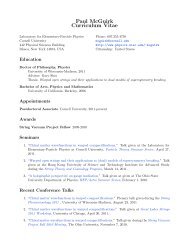
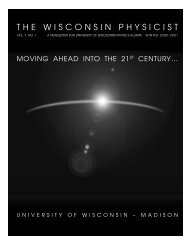
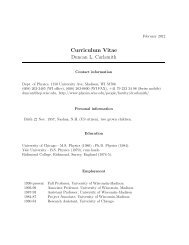
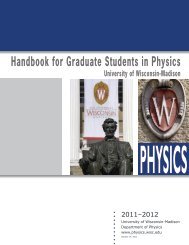

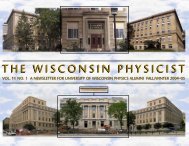

![The Symmetric Linear Potential [ ]](https://img.yumpu.com/25329322/1/190x245/the-symmetric-linear-potential-.jpg?quality=85)
